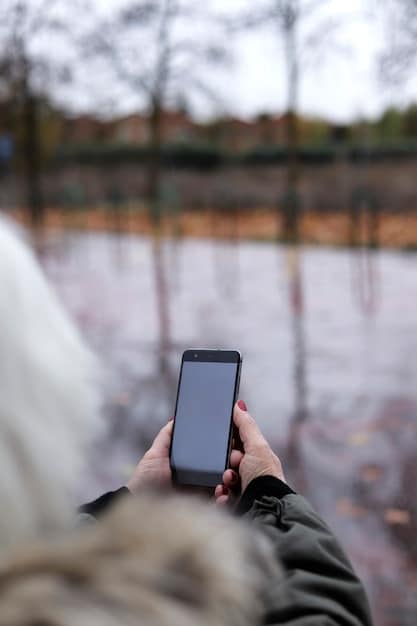Digital Detox: Reconnect with Yourself in Just 2 Hours

A digital detox involves intentionally disconnecting from technology for a set period, such as 2 hours a day, to reduce stress, improve focus, and reconnect with oneself through alternative activities and mindful presence.
In today’s hyper-connected world, it’s easy to feel overwhelmed by the constant barrage of notifications, emails, and social media updates. A digital detox, disconnecting from technology for just 2 hours a day, can be a powerful way to reclaim your time and reconnect with yourself.
What is a Digital Detox and Why Is It Important?
A digital detox is essentially a conscious decision to reduce your technology usage. It’s about creating space to disconnect from screens and reconnect with the physical world, your thoughts, and your feelings.
But why is this disconnect so important? In our modern society, we’re constantly bombarded with information. This constant stimulation can lead to stress, anxiety, and a decreased ability to focus.
The Benefits of Disconnecting
Taking regular breaks from technology can lead to a wide range of benefits, both mental and physical.
- Reduced Stress: Constant notifications and emails can trigger the stress response. Disconnecting provides a much-needed respite.
- Improved Focus: By minimizing distractions, you can sharpen your concentration and improve productivity.
- Better Sleep: Blue light emitted from screens can interfere with melatonin production, disrupting sleep patterns. A digital detox, especially before bed, can improve sleep quality.
- Enhanced Relationships: Spending less time on devices allows you to be more present and engaged with the people around you.
Ultimately, a digital detox is about finding a healthier balance in our relationship with technology. It’s about using technology mindfully, rather than letting it control us.

Preparing for Your 2-Hour Digital Detox
Embarking on a digital detox requires some preparation to ensure success. It’s not just about turning off your devices; it’s about creating a supportive environment.
Planning is key to making your digital detox a positive experience. Being unprepared can lead to frustration and make it harder to stick to your commitment.
Set Clear Boundaries
Define what “digital detox” means to you. Which devices will you avoid? Are there any exceptions (e.g., emergencies)?
Communicate Your Intentions
Let your friends, family, and colleagues know when you’ll be unavailable. This will minimize expectations and potential disruptions.
- Inform Your Family: Let your family know when you will be detoxing so they know when they can reach you.
- Set an Out-of-Office Message: For work emails, enable an automated response during your detox window.
- Find a Support System: Share your plan with friends who might want to join you.
With careful planning, you can create a smooth and enjoyable digital detox experience, making it easier to reap the rewards.
Activities to Enjoy During Your Digital Detox
Once you’ve disconnected from technology, it’s important to have alternative activities lined up to fill the void. This will help you stay engaged and resist the urge to check your phone.
The possibilities are endless, and the best activities will vary depending on your interests and preferences. The goal is to find activities that are engaging and fulfilling without relying on screens.
Embrace Nature
Spending time outdoors can be incredibly restorative. Go for a walk in the park, hike in the woods, or simply sit in your garden and enjoy the fresh air.
Engage Your Creativity
Unleash your inner artist. Paint, draw, write, play a musical instrument, or try a new craft.
Connect with Loved Ones
Dedicate quality time to the people in your life. Have a conversation, play a board game, or cook a meal together.
- Read a Book: Immerse yourself in a good story without the distraction of notifications.
- Practice Mindfulness: Meditate, do yoga, or simply focus on your breath to cultivate a sense of calm and presence.
- Physical Activity: Exercise and get your body moving; this releases endorphines.
By exploring alternative activities, you may discover new passions and hobbies that enrich your life beyond the digital realm.
Overcoming Challenges and Staying Consistent
Even with careful planning, challenges can arise during your digital detox. The key is to anticipate these hurdles and develop strategies to overcome them.
It’s also important to be kind to yourself. If you slip up, don’t beat yourself up. Just acknowledge it and recommit to your detox.
Fight the Urge to Check In
The temptation to check your phone can be strong, especially at first. Acknowledge the urge without acting on it. Distract yourself with an alternative activity.
Minimize Temptations
Physically remove your devices from your immediate vicinity. Put your phone in another room, turn off notifications, and download apps to disable the internet for a certain amount of time.
Be Patient
It takes time to break old habits. Don’t get discouraged if you struggle at first. Consistency is key.

- Avoid Idle Moments: Keep yourself busy with activities so you’re less likely to reach for your phone.
- Turn Off Notifications: If you need to keep your phone nearby, disable all push notifications to avoid temptation.
- Reward Yourself: Celebrate your successes to stay motivated.
Remember that consistency is essential for long-term success. Set a realistic schedule and stick to it as much as possible. Don’t be afraid to adjust your strategy as needed.
The Psychological Impact of Disconnecting
Disconnecting from technology isn’t just about physical separation; it also has profound psychological effects. It allows you to reconnect with your thoughts, feelings, and inner self.
By taking time to disconnect, you can cultivate a deeper sense of self-awareness and emotional well-being. This can lead to greater clarity, resilience, and overall happiness.
Increased Self-Awareness
Without the constant distractions of technology, you have more space to reflect on your thoughts, feelings, and values.
Reduced Anxiety
Social media can fuel anxiety by creating a sense of competition and comparison. Disconnecting can help you break free from these pressures.
Improved Mood
Studies have shown that reduced screen time can lead to improvements in mood and overall psychological well-being.
Integrating digital detoxes into your life can transform your mindset and well being.
Maintaining a Healthy Relationship with Technology
The goal of a digital detox isn’t to abandon technology altogether, but rather to cultivate a healthier, more mindful relationship with it. It’s about using technology intentionally, rather than letting it use you.
Achieving this balance requires ongoing effort and self-awareness. It’s about setting boundaries, being present in the moment, and prioritizing real-life connections.
Mindful Usage
Be conscious of how and why you’re using technology. Ask yourself if it’s truly serving your needs and values.
Set Time Limits
Use apps or website blockers to limit your screen time on specific platforms.
Create Tech-Free Zones
Designate certain areas of your home (e.g., bedroom) as tech-free zones.
- Schedule Regular Detoxes: Incorporate regular digital detoxes into your routine, whether it’s a few hours each day or a longer break each week.
- Prioritize Real-Life Interactions: Make an effort to connect with people in person, rather than relying solely on digital communication.
- Reflect on Your Usage: Periodically assess your relationship with technology and make adjustments as needed.
Cultivating a mindful relationship with technology is an ongoing journey. By being intentional and self-aware, you can harness the benefits of technology without sacrificing your well-being.
| Key Point | Brief Description |
|---|---|
| 🧘♀️ Mindfulness | Regular practices enhance self-awareness and reduce stress. |
| 🌳 Nature | Spending time outdoors can significantly reduce digital fatigue. |
| 🎨 Creativity | Engaging in creative pursuits offers a fulfilling alternative to screen time. |
| 🫂 Connection | Dedicated time with loved ones strengthens relationships. |
Frequently Asked Questions
▼
A digital detox is a period where you intentionally reduce or abstain from using digital devices such as smartphones, tablets, and computers. It’s a chance to disconnect and focus on other activities.
▼
Digital detoxes can reduce stress, improve sleep, enhance focus, and promote better mental health. They help you regain control over your time and attention, leading to a more balanced lifestyle.
▼
The duration can vary based on your needs. Starting with 2 hours a day can be a great initial target. Some people opt for longer periods, like a weekend or even a week-long detox.
▼
Engage in activities like reading, exercising, spending time in nature, pursuing hobbies, or connecting with loved ones. Choose options that help you unwind and enjoy the physical world.
▼
Set clear goals, communicate your intentions to others, prepare alternative activities, and be patient with yourself. Start slowly and build momentum to make it a sustainable practice.
Conclusion
Embarking on a digital detox, even for just 2 hours a day, can be transformative. By intentionally disconnecting from technology, you can reduce stress, enhance focus, and reconnect with yourself and the world around you. It’s about finding a healthier balance and reclaiming your time and attention in a world that’s increasingly demanding of both.





